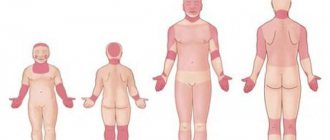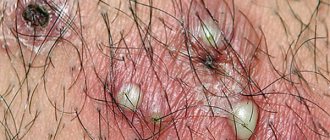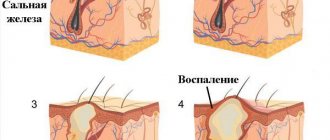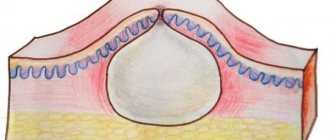Benign subcutaneous neoplasms of intimate areas are a common pathology, especially often diagnosed in women over thirty-five years of age who have problems with excess body weight and suffer from hormonal disorders.
Fatty deposits of the external genitalia are divided into two broad groups: lipomas, which are characterized as growths of adipose tissue, and atheromas, which are cysts of the sebaceous ducts.
In the early stages of development, wen does not cause discomfort or other unpleasant sensations. But against the backdrop of gradual progression of the pathology, growth of neoplasms, their constant injury, and an increased risk of complications are observed. To prevent possible negative consequences, it is not recommended to postpone a visit to a specialist for a long time.
What is it and why does a wen appear in the groin in women?
Pathological growth of adipose tissue and accumulation in one place, forming a compaction, is called lipoma in medicine. This neoplasm is benign and its development is not accompanied by any symptoms. It can appear on any part of the human body, and internal organs are no exception. This type of wen in the groin develops much more often in women than in men. The reasons that determine its appearance and development in humans still remain a mystery to doctors.
Fatty cyst in an intimate place
Wen in the genital area
The content of the article
A fatty tumor or lipoma is a benign formation that appears in the form of a lump on the body and consists of adipose tissue cells. It mainly affects the upper body: back, stomach, arms, face. However, lipomas can also form in the genital area. What is the cause of lipomas in intimate places? How to get rid of such an unpleasant formation?
Causes and symptoms of the disease
photo of a wen in the intimate area
Although lipomas do not pose a threat to human life, their frequent appearance on the body may indicate certain disorders within the body. There are two reasons for the appearance of lipomas on the skin:
- disruption of the internal outflow of sebum to the surface of the skin. This leads to stagnation of sebaceous secretion with further formation of lipoma in this area;
- change in the consistency of the sebaceous secretion: it becomes very thick, so it cannot freely penetrate through the skin pores, it stagnates in the form of balls in the subcutaneous tissue, causing partial swelling of the dermis, with the subsequent formation of a lump.
Such changes and disruptions in the functioning of the sebaceous glands are a consequence of certain diseases of the body. These may be endocrine diseases, gastrointestinal tract malfunctions, and fat metabolism disorders. Insufficient personal hygiene cannot be ruled out, which can lead to the accumulation of old sebum on the surface of the skin, thereby preventing the normal release of new sebum. There is a special classification of lipomas. They come in the following types:
- diffuse, which do not have a shell consisting of connective tissue;
- encapsulated, which form on the surface of internal organs;
- fibrous, the structure of which is dense, since such lipomas consist largely of connective tissue;
- petrified, formed as a result of salt deposition;
- ossified, which arise due to the proliferation of bone tissue;
- tree-like, the localization of which penetrates into the joint area.
lipoma in section
A fatty tissue that appears in the genital area, most often on the labia in women and on the scrotum in men, resembles a soft, rarely hard, nodule to the touch, rising above the skin. A yellow ball can be seen through the mucous membrane, consisting
kistaportal.ru
Symptoms and types of formations in the groin
In order to determine the method of treatment for the formation, it is necessary to diagnose the type of tumor in the groin and make sure that the tumor is not malignant. A lump in the groin area may have the following characteristics:
- the appearance of a growth can provoke an inflammation process in the lymph nodes that are localized nearby;
- An inguinal hernia may look similar to a lipoma in appearance, but its symptoms are distinguished by pain and a feeling of heaviness at the site of the pathology. You can accurately determine the bulge in the groin using an ultrasound examination;
- the lipoma body, exposed to constant contact with linen and other clothing, is prone to activation of the development of pathological cells and degeneration into liposarcoma. This malignant tumor is more common in male patients. The survival rate of patients with this disease is about 50%.
If a lump is detected in the groin area, it is necessary to seek medical help to determine the nature of the tumor and begin timely treatment.
If nerve trunks are located near the neoplasm, then their compression by the body of the wen may be accompanied by pain. But often the compaction does not manifest itself with any symptoms. The subcutaneous neoplasm does not hurt, does not itch, and does not change the color of the skin. On palpation, the inguinal lipoma has a soft consistency, spherical shape with clear boundaries. The fatty tissue, as a rule, is enclosed in a membrane, but there are diffuse ones that do not have a capsule. Such neoplasms are dangerous because they grow into neighboring healthy tissues. Most often, the inguinal subcutaneous wen is single, but sometimes multiple developments are observed. There are several types of lipomas:
- diffuse - formations of adipose tissue that do not have a shell and precise boundaries;
- xanthomas are flat-shaped neoplasms whose capsule is very thin or completely absent;
- pedunculated lipomas are characterized by sagging subcutaneous wen;
- fibrolipomas - neoplasms from connective fibrous tissue and fat cells;
- angiolipomas - tumors with interlacing blood vessels;
- myolipomas are formations consisting of smooth muscle tissue.
Lipomas and atheromas: similarities and differences
A lipoma, like a node in the groin, is a benign tumor on the skin. The two neoplasms are identical in appearance: round with clear contours, develop painlessly and do not itch. But they differ from each other.
- The lipoma is less mobile under the skin. When pressed with a finger, the cyst will pop out, but the wen will remain in place.
- A black dot is visible on the cystic formation - a duct that is clogged.
- Inflammation for cysts is a common occurrence.
- The fatty tissue does not change size.
The cyst breaks out on its own, and the pus comes out. But it happens that the contents of the atheroma leak into the tissue. This is dangerous due to intoxication, infection and sepsis.
Cyst in the perineum
Problems with the function of the glands, failure to comply with personal hygiene rules, and contact with tight underwear lead to a paraurethral or Bartholin gland cyst. The size of which reaches 4 cm.
Bartholin's gland. Narrowing of the excretory duct is the cause of the disease. STDs affect inflammation of the gland. E. coli, staphylococci and streptococci reduce the body's resistance. Chronic diseases are the cause of infection. Sometimes an abortion results in the appearance of a cyst.
A Bartholin gland cyst causes discomfort when moving and discomfort during sex. An abscess in the perineum is the cause of fever and a sharp deterioration of the condition.
Paraurethral cyst is round. The development of the disease is caused by inflammatory processes of the urethra and vagina, and sexually transmitted diseases.
Cysts in the perineum cause painful urination, pain, burning and itching, and the release of pus. If a ball or swelling is detected in the perineum, contact a gynecologist or surgeon. If the process is severe, the tumor is removed in a specialized room - a capsule containing masses of the result of decomposition is removed. It is not recommended to open it yourself. This provokes the development of new pathologies.
Which doctor should I contact if detected?
Faced with the problem of a wen in the groin, many do not know which doctor treats such pathologies. With any tumors, you should contact a surgeon, who will assess the condition and size of the tumor and prescribe the necessary examinations and tests. Based on the diagnostic results, a qualified doctor can determine the appropriate treatment method.
Each individual case is considered individually, so you should not imitate a similar problem of your friends and use the same method of treatment that was prescribed to them. The fact is that an unauthorized attempt to remove a lipoma can pose a serious threat to the patient’s health.
Did you know that papillomas, warts and moles can be caused by parasites in the body?
According to the latest WHO data, it is the numerous parasites that live in the human body that are the cause of almost all fatal human diseases, including the formation of cancerous tumors.
Statistics tell us that every 9 people get cancer with similar rashes:
- Papillomas..
- Unusual moles.
- Warts.
- Pimples.
- Unknown spots.
- Redness for no reason...
All this is possible due to weakened immunity, due to the fact that parasites have appeared in the body!
.
But there is a medicine, and medicine is in no hurry to advertise the CORRECT methods of treatment, since it is not profitable for them. This is what the girl who coped with this illness says
Watch before the site is blocked. Find out here >>>
Wen is a rather unpleasant acquisition, especially if it affects intimate parts. Most patients, having discovered a lump in the groin, mistake it for a pimple and leave it alone to resolve. Or, on the contrary, they are trying to squeeze it out. Neither one nor the other can be done if a lipoma is disguised as a pimple.
Methods for treating wen on the pubic part
In modern medicine, there are a number of methods for treating inguinal lipoma, which depend on the size, nature and condition of the formation:
- liposuction or suction of the contents of the wen is performed through a small incision in the tissue (0.5 cm) using a lepoaspirator. This method is good because it leaves an invisible mark after the procedure. The downside is that the tumor capsule remains at its location, which can subsequently lead to relapse;
- removal using radio wave surgery. This method is used for small formations up to 3 cm in size. The operation is performed under local anesthesia with a radio wave scalpel, which, when cutting tissue, is able to block bleeding from small vessels. Postoperative marks remain neat and unnoticeable. The use of this procedure is contraindicated in patients with a pacemaker;
- laser removal of wen. This method is one of the most effective. The procedure minimizes the reappearance of the formation and also reduces the likelihood of postoperative swelling and inflammation. The high precision of the laser beam allows it to practically not affect nearby healthy tissue. Excision of the lipoma is performed along with its membrane. The disadvantage of the operation is the impossibility of getting rid of large growths that are deep in location;
- surgical method. Traditional surgery is a radical method of removing tumors, including in the groin area. This method of treatment is prescribed to patients with large tumors (more than 5 cm). Local anesthesia is used; the quality and aesthetics of the suture depend on the competence of the specialist.
Treatment with folk remedies
Before starting treatment at home, you should make sure that the neoplasm is a lipoma and not another tumor, and make sure that it is benign.
There are many “grandmother’s” proven recipes that effectively help get rid of wen on the body. Some of them are:
- Take cinnamon orally, 1 teaspoon twice a day until the growth goes away.
- Grind a medium-sized baked onion on a grater. Do the same with a small piece of laundry soap. Mix the ingredients and apply the resulting slurry to the wen. The compress should be fixed at the site of formation and changed every 10 hours.
- Grate the carrots on a fine grater, add powdered cumin and fresh wild rosemary leaves. This compress must be done 2 times a day until the result is noticeable.
- Mix butter (50 g) with watercress juice (2 tablespoons) until smooth. Apply the mixture to the lipoma and change it once a day.
- Cut the aloe lengthwise and apply to the formation overnight. The procedure must be repeated every day until the skin formation exposes the core of its contents. You can also use Kalanchoe and golden mustache.
- Chop the coltsfoot and place on cheesecloth. The resulting mass should be applied to the tumor 3 times a day until the wen disappears.
These methods can be effective for small lipomas in the initial stages of their development. Large tumors cannot be cured with ointments, compresses and decoctions. If the formation develops rapidly and exhibits any symptoms, you should immediately contact a specialist.
It is quite difficult to distinguish the accumulation of normal tissue under the skin from a malignant tumor at home. They all look like a small lump, but a lump in the groin in women has specific symptoms. Even if all the signs point to a lipoma, you should not self-medicate, and now we will explain why.
Prevention methods
To prevent the appearance of primary wen and their recurrence, it is recommended to adhere to the following rules:
- monitor hormonal levels by periodically visiting an endocrinologist;
- lead an active lifestyle, play sports, do gymnastics in the morning;
- control weight;
- maintain personal hygiene, overweight women take a shower at least once a day, and in the summer in the morning and evening every day;
- wear cotton underwear, which should be changed every day;
- do not smoke, do not abuse alcohol;
- have a regular sexual partner, practice protected sex;
- protect the skin with special clothing in hazardous industries;
- avoid rubbing the labia, excessive sweating in the perineum;
- When washing, use gels for intimate hygiene.
A healthy, balanced diet plays an important role in preventing the appearance of atheromas and lipomas. The rules are simple - eat more vegetables, fruits, seafood and white meat. Limit fried, fatty, smoked foods. Products containing fast carbohydrates affect weight gain and should be excluded from the diet. Normal metabolism, which affects the condition of the epidermis, depends on proper nutrition.
The nature of the wen and the reasons for its appearance
A lipoma or wen is a benign structure that cannot be called a tumor, since it does not contain pathological cells. The formation arises from a focus of adipose tissue, which has begun to grow rapidly.
The wen looks like an ordinary lump. Distinctive features: softness, painlessness, mobility. The danger of a lipoma in the groin is that it is constantly exposed to friction, which increases the risk of inflammation.
Wen lesions most often occur in middle-aged women. Medicine cannot yet explain the reasons for this phenomenon. Most often, the lipoma is invisible even to the patient. It can be diagnosed by testing for a hernia, tumor, and lymphadenitis (inflammation of the lymph nodes). If you discover a strange formation on your pubic area, you should not postpone a visit to a dermatologist.
Not a single theory of the occurrence of wen put forward by medicine has been fully proven. Experts can only point out certain factors that were most often found in patients with formations in the groin.
Reasons for the development of lipoma
- Genetic predisposition. It is believed that for this reason wen appears in young children. The lipoma in the girl’s groin needs to be removed urgently, otherwise as it grows it will put pressure on nearby tissues, blood vessels, nerves and organs.
- Metabolic disorders that affect the entire body. First of all, these are metabolic pathologies in adipose and connective tissue. When there is an excess of cholesterol in the body, sebum clogs the glands.
- Endocrine diseases. The formation of wen is greatly influenced by an imbalance of thyroid hormones.
- Hematopoietic diseases, problems with cleansing the body of toxins.
- Unbalanced diet. Food of non-biological origin leads to contamination of the body.
- Abuse of cigarettes and alcoholic beverages.
Types and signs of development
Most often, xanthomas (thin lipomas without capsules), diffuse formations (weak lobular structure), fibrolipomas (mainly connective tissue), and angiolipomas (contain blood vessels) appear in the pubic area.
Sometimes a so-called pedunculated lipoma occurs when, under the influence of gravity and its own size, the formation sags and a thin process forms. Wen in the groin can be single or group.
Wen in the groin can grow at different rates. Most patients have no pain. Unpleasant sensations are noted only when the nerve trunk is close. Externally, the lipoma looks round in shape and hairs may grow from the skin above it. When palpated, the presence of a capsule and a soft consistency in it are noted.
With constant friction with underwear and clothing, the inguinal lipoma will inevitably become inflamed. A symptom of this process is the accelerated growth of formation, pain and swelling appear.
Inguinal wen: removal necessary
A fatty deposit in the groin area, scientifically speaking, a lipoma is a fairly common phenomenon. It looks like a small bump under the skin. This tumor usually does not hurt, but causes some discomfort because there is constant contact with underwear and clothing.
Wen in the groin is more common in women than in men. Unfortunately, the reason for this fact is still unknown. Lipoma is diagnosed in connection with suspicion of other diseases, for example, a hernia, malignant tumor or lymphadenitis. This is why it is extremely important to get examined as soon as possible if a tumor has formed in the bikini area.
Nature of education
The reason for the formation of lipomas is not fully understood.
However, experts identify the following factors why wen appears in this area:
- Heredity. For this reason, wen in the groin occurs in young children. Fat deposits in children must be removed, otherwise they can enlarge and put pressure on organs.
- Metabolic disorders affect the entire body system, including adipose and connective tissue, from which lipomas are formed. Excess cholesterol makes the fat under the skin more viscous, which leads to blockage of the sebaceous gland ducts and the accumulation of adipose tissue.
- Failure in the hormonal system. An imbalance of thyroid hormones often causes the formation of tumors from subcutaneous fat.
- Diseases of the organs responsible for removing toxins and excess fluid from the body and hematopoiesis (liver, kidneys) contribute to the appearance of wen.
- Poor nutrition. The food of modern man contains many ingredients of non-biological origin that clog the body and disrupt the process of its cleansing.
- Alcohol abuse.
Types of inguinal lipomas
The following benign neoplasms are most often diagnosed in the groin area:
- Xanthomas are flat-shaped lipomas, non-capsular, thin and soft.
- Fibrolipomas are neoplasms consisting predominantly of connective tissue.
- Diffuse - lipomas that have grown in width with a weakly defined lobular structure.
- Angiolipomas are lipomas riddled with blood vessels.
- Lipomas on the leg. As a rule, this is a large tumor, which, under the influence of gravity and its own weight, sags downwards, forming a kind of “leg”.
Neoplasms in the groin can be single or multiple, medium or large in size.
Symptoms and consequences
Externally, the wen looks like a capsule (with the exception of xanthomas) covered with skin. Hair often grows on it and it has a good blood supply. The wen does not cause pain if there is no nerve trunk next to it.
Since the inguinal wen undergoes constant friction against clothing, inflammation or increased growth may occur. Usually inspection and palpation are sufficient to make a diagnosis.
But undergoing additional examination is important, since it is necessary to exclude other diseases and make sure that the tumor is safe.
Symptoms of lipoma in the groin are similar to lymphadenitis - inflammation of the lymph node. With this pathology, the lump causes unpleasant painful sensations, and if treatment is ignored, it will cause serious intoxication for the patient. A hernia in the groin is determined during examination and using radiography and ultrasound. The difference between lipoma and low-quality tumors is determined by analyzing the contents using the biopsy method.
Fatty tumors, as a rule, do not degenerate into malignant neoplasms, but lipomas in the groin area can become a big problem if they are not treated.
Over time, the wen becomes denser due to thickening of the capsule.
During contact with clothing, constant friction against it causes injury to the tumor or inflammation, which can cause liposarcoma - a malignant neoplasm.
Lipoma in the groin in women, diagnosis and consequences
Often, when self-diagnosing, patients confuse wen with lymphadenitis. But when the lymph node becomes inflamed, pain occurs from the beginning of the process. If you ignore lymphadenitis, the patient will experience intoxication, and the consequence of inattention to the wen will only be inflammation.
Often, it is enough for a doctor to feel the structure and listen to complaints to make a diagnosis. Additional examinations are needed to exclude oncology. You can distinguish a benign structure from cancer by performing a biopsy (content analysis). Ultrasound and radiography methods allow differential diagnosis.
Such structures extremely rarely turn into malignant tumors. But such an outcome is quite possible. You need to treat a lipoma in the groin on time. Waiting tactics can only be used after consulting a doctor and with his constant monitoring.
Since the wen in the groin is constantly subject to friction, it is better to remove it immediately after diagnosis. If this is not done, the capsule will begin to thicken, and as a result, the wen will begin to thicken and grow. Injury to the wen will lead to inflammation, which can trigger the development of liposarcoma.
How to treat a Bartholin gland cyst
The diagnosis is made by a gynecologist based on the results of an examination in a chair (the swelling is visible to the naked eye) and the patient’s complaints. He also decides how exactly to treat the Bartholin gland cyst. The doctor takes into account the patient’s age, the reasons for its appearance, and the characteristics of its course. Additional examinations are prescribed:
- smear analysis for the presence of microorganisms;
- blood test for inflammation;
- after 40 years of age, a biopsy is performed - a study of cells for a cancerous tumor.
For the treatment of Bartholin gland cysts, the following are used:
- warm sitz baths, which can help reduce unpleasant symptoms and open the duct;
- therapy with antibacterial drugs for existing concomitant diseases, infectious process;
- drainage with installation of a catheter to drain mucus for up to 6 weeks;
- puncture of cystic contents with a needle, when it is impossible to perform a standard operation (for example, in pregnant women);
- surgical formation of a new wide (up to 6 mm) duct – marsupialization;
- complete removal of the gland.
When treating a Bartholin gland cyst surgically, general or local anesthesia is used. When installing drainage, the woman will experience discomfort in the first days, but later its level decreases. Complete abstinence is recommended, do not visit the sauna, do not take hot baths, and avoid heavy physical activity.
It is important to entrust the treatment of a Bartholin gland cyst to a gynecologist and adhere to medical recommendations as much as possible. In this case, the chance of recovery and absence of relapse is quite high.
*Impact factor for 2020 according to RSCI data
The journal is included in the List of peer-reviewed scientific publications of the Higher Attestation Commission.
Read in the new issue
Periarthritis is a lesion of the paraarticular tissues (PPAT) of the joints. Paraarticular tissues represent a collection of periarticular structures and tissues distant from the joints. The article describes the most common diseases of the paraarticular tissues of the lower extremities: enthesitis, tenosynovitis, ligamentitis, fasciitis, bursitis. The issues of their etiology, pathogenesis, clinical picture, diagnosis, and differential diagnosis are described. Diagnosis of PPAT is based on the presence of local changes: pain, induration, edema, hyperthermia, hyperemia. PPAT are characterized by local mild or severe pain, sometimes radiating along the involved tendon-ligamentous, muscle and nerve structures. Pathogenetic therapy for these diseases is presented. In the treatment of PPAT, the predominant place is occupied by the exclusion of provoking factors, primarily mechanical overloads. Good clinical results can be achieved by local administration of glucocorticoids (GC), taking into account the anatomical and morphological features of PPAT, indications, contraindications, correctly chosen dose, number and frequency of injections. Anti-inflammatory therapy for PPAT includes, first of all, non-steroidal anti-inflammatory drugs (NSAIDs) in the form of local (cutaneous) and systemic use. Analgesics, weak opioids, muscle relaxants, and sedatives are also used. Previously, our journal published an article in which PPAT of the upper extremities and back was discussed in detail [Khitrov N.A. Paraarticular tissues: variants of lesions and their treatment // Breast cancer. 2020. No. 3. pp. 177–184.
Treatment of lipoma in a woman's groin
Often, inguinal wen is much larger than similar formations on the head and other parts of the body. For this reason, their removal is recommended even with weak growth. No ointments or compresses will help get rid of lipoma; most often, such treatment only leads to severe inflammation of the structure.
Modern surgical treatment is much safer and faster than home treatment. The removal procedure takes no more than half an hour, does not cause pain and is the most reliable method.
Methods for removing inguinal lipoma in women
- Traditional surgery. The operation allows you to get rid of the entire structure, protecting the patient from relapse. The procedure involves opening the wen, removing the contents and capsule, and suturing the wound.
- Laser therapy. Laser removal of a tumor is considered the fastest method: the rehabilitation period is significantly reduced, the risk of complications is reduced, and there are no scars left. The carbon dioxide laser ensures a bloodless operation, has a targeted effect, and does not damage adjacent tissues.
- Radio wave therapy. The method is preferred for removing small lipomas. The structure is removed remotely, after which only a small depression remains, which will heal over time.
- Liposuction. The operation involves sucking out the contents with a special device. The method is the most risky, since the doctor cannot control the removal of the entire capsule.
Traditional methods of treating inguinal wen
When there is no desire to undergo surgery for small lipomas, you can try to reduce it using proven folk recipes. However, you need to remember that you can use any products only after the approval of a dermatologist.
Recipes for inguinal lipoma in women
- Propolis. You need to melt a little propolis, crumple a small cake and apply it to the bump for 40-60 minutes. For convenience, the cake should be fixed with film. The procedure must be repeated daily for 14 days, however, this method is safe only for small lesions.
- Coltsfoot. To treat wen, you need grass leaves. You should crush them into powder, sprinkle the cone thickly, wrap it in film and bandage. Coltsfoot therapy can be continued until the structure is significantly reduced.
- Onion. The baked onion needs to be crushed (preferably in a blender), add a little laundry soap. The resulting mixture is suitable for lubricating lipomas in the groin. A small lump usually takes two weeks to shrink.
A woman is obliged to monitor the condition of her skin. To prevent the occurrence of wen, you need to eat right, cleanse your skin regularly and prevent dermatological diseases.
- 4 minutes to read
The development of a wen is an extremely unpleasant phenomenon, especially if it appears in the intimate area. Many patients, faced with a lump in the groin, mistake the formation for a regular pimple. In such cases, patients either squeeze it out or leave it alone to resolve on its own. Doing this is strictly prohibited if a wen is disguised as a pimple.
Content
Clinical picture
If the tumor is small, it may not be noticeable. Clinical manifestations depend on what influenced the appearance of the tumor, but the pathology is always accompanied by discomfort.
At the initial stage of development, the spread of the inflammatory process is observed, which is accompanied by the following symptoms:
- Pain . Occurs when walking.
- Itching . Intensifies at night.
- Redness of the upper layer of the epidermis.
- Increased temperature .
- Burning and hyperemia.
- Loss of appetite . As a result, the patient begins to rapidly lose weight.
- Headache dizziness .
- Changes in the clinical blood .
Based on the manifestations, a wen in the groin can be distinguished from various types of hernias, which manifest themselves in the form of:
- Constipation or flatulence.
- Tachycardia and fever.
- Nausea.
- Increased body temperature.
- Pain in the lumbar region.
The main difference is that the tumor increases when sneezing or straining. In this case, the disease is accompanied by redness and bluish discoloration of the skin in the area of hernia formation.
In cases where the cause of the appearance of a lump is varicose veins or the formation of blood clots in the vessels, pulsation is observed in the area of the neoplasm. In this case, the surface of the bump becomes lumpy, and the pain radiates to the leg.
Thus, based on clinical manifestations, one can easily distinguish a wen in the intimate area from a hernia and other pathologies that are similar in appearance.
It is strictly not recommended to make a diagnosis and prescribe treatment on your own, as this should be done by the attending physician. When the first symptoms appear, you should consult a specialist.
What it is
A fatty tissue or, as it is also called, a lipoma, is a benign formation, which is a small lump under the skin that has a soft consistency.
Externally, a lipoma looks like a small subcutaneous lump. The formation is not accompanied by painful sensations, but the patient may experience severe discomfort caused by close contact of the wen with underwear.
According to statistics, men experience a lump in the groin much less often than women. But doctors cannot determine the exact reasons for the formation of lipoma. Therefore, a wen is diagnosed if the development of other formations is suspected, including lymphadenitis or hernia.
Can a wen of such localization lead to consequences?
Lipoma is a benign element and does not cause harm to the body unless it grows or becomes inflamed. At the initial stage it brings only aesthetic discomfort. A large lesion can compress blood vessels. The contents are an environment for the development of infections and, when bacteria enter, the wen begins to fester and become inflamed. The epidermis is thin, it is not difficult to damage the formation. You should not delay visiting a doctor if tumors are detected on the labia.
The article has been reviewed by the site editors
Causes
There are no exact reasons for the appearance of lipomas in the groin, but there are certain factors that contribute to the development of pathology. These include:
- development of liver and kidney diseases;
- disruption of metabolic processes in the body;
- poor hygiene, use of low-quality cosmetics;
- mechanical damage to the skin resulting from injury;
- excess weight;
- the presence of bad habits such as smoking, alcohol abuse, unhealthy diet;
- hormonal imbalance ;
- increased oily skin (if the problem is present on the front part, then the skin in the groin area will also be oily.
Characteristic symptoms
Visually, a lipoma is a small capsule covered with skin. Hair often grows on the formation, since it is provided with good blood flow.
Painful sensations do not occur when a wen appears. But if there is a nerve trunk next to the lipoma, then the pathology may be accompanied by combat syndrome.
Some symptoms may be associated with constant friction of the wen against the underwear. In such cases, an inflammatory process develops, which provokes increased growth of the formation.
To avoid this, at the first suspicious symptoms indicating the appearance of a lipoma, you should immediately consult a doctor.
Causes and symptoms of Bartholin gland cyst
The exact causes of pathological adhesion of the ducts have not been identified. Risk factors:
- mucosal injuries during gynecological procedures, operations, shaving;
- tight, synthetic underwear;
- insufficient personal hygiene.
Less commonly, blockage occurs from infectious STDs.
Symptoms of a Bartholin gland cyst are:
- spherical swelling of the labia, ranging in size from 1 to 8 cm;
- discomfort, pain during movements, sexual intercourse.
If an inflammatory process has begun (infection from pathological microorganisms), the condition is worsened by a sharp increase in temperature and swelling of the lymph nodes. Infection can develop rapidly within a few days from the moment the first signs of a Bartholin gland cyst appear. The process is rarely bilateral; more often pathologies are formed on one side.
Can it develop into cancer?
Lipomas that arise in the groin area, as a rule, do not develop into cancer, but in the absence of quality therapy, lipomas can cause many problems. As it develops, the wen becomes denser, thereby creating a feeling of discomfort.
With constant contact of the tumor with clothing, liposarcoma, a malignant mesenchymal tumor, can occur. The formation develops against the background of constant trauma to the lipoma, but this is quite rare.
Diagnostic features
If acne appears in the lower abdomen, indicating the development of a wen, you should immediately consult a doctor for a diagnostic examination.
Diagnosis is carried out by a dermatologist, who, after a visual examination, will prescribe additional diagnostic measures. Most often, a biopsy, histological tests or ultrasound are prescribed.
After surgical removal of the wen, doctors may also prescribe some diagnostic procedures. This will allow you to decide on further therapy.
Treatment methods
Modern medicine offers several methods for treating lipomas in the groin, the choice of which depends on the condition of the tumor, its nature and size. We are talking about a surgical method, the use of a laser and exposure to radio waves. Each of these methods has its own characteristics, which will be discussed further.
Surgical method
A common way to remove a lipoma is radical surgery. Prescribed to patients with wen, the diameter of which is more than 5 cm.
The operation is performed under local anesthesia. Upon completion, a postoperative scar remains on the patient’s body, the aesthetics and nature of which directly depends on the skill level of the surgeon.
Laser removal
An effective method of treating wen in the groin area using a laser. The procedure reduces the likelihood of relapse, and after laser exposure, the chances of developing an inflammatory process or swelling are almost zero.
Thanks to high-precision equipment, the laser beam does not affect healthy tissue when removing a wen. The lipoma is excised along with the membrane. Among the disadvantages of the laser method, it is worth highlighting the ineffectiveness of its use when removing large formations.
Radio wave surgery
Doctors resort to this method of therapy in cases where the size of the tumor does not exceed 3 cm. To perform radio wave surgery, which takes place under local anesthesia, a special instrument is required - a radio wave scalpel. With its help you can prevent vascular bleeding.
Upon completion of the operation, subtle marks remain on the patient’s body. The use of radio waves has its contraindications, which include the use of a pacemaker. Therefore, people who wear this device need to remove the wen using alternative methods.
Liposuction
A relatively new method of removing tumors is by suctioning out its contents through an incision made on the patient’s body. The procedure is performed using a lepoaspirator. Once lipomas are removed, there is virtually no trace left on the body, which is why many people choose liposuction.
Possible complications
The formation of a wen in the groin area often leads to the development of an inflammatory process, so the problem must be gotten rid of as soon as it appears. Ignoring symptoms can lead to infection of the affected area or suppuration.
Complications can also arise in cases where the patient, mistakenly mistaking a wen for an ordinary pimple, independently tried to squeeze it out. In this case, infection may occur and it is no longer possible to prevent a relapse of the disease.











